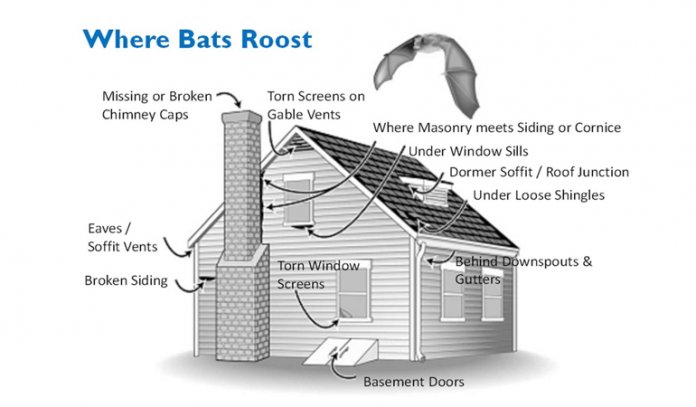While bats are natural predators of some pesky and dangerous insects and pollinate plants which make them great neighbors to have, there are multiple reasons why you shouldn’t have them inhabiting your attic or home.
Some of the dangers of having bats in the attic include the risk of becoming infected with histoplasmosis from the bat droppings (bat guano) by inhaling the spores of the harmful fungus, as well as a risk of rabies when coming in contact with the blood, urine, and fur of the bats. Bats in the attic can also cause the growth of other harmful pathogens and bacteria through the droppings.
People have also reported having bats die inside their attics and in the walls, which can cause a pungent stench and also about structural damage to the house due to the droppings.
Last but not least, bats can be scary, especially if you are not expecting to meet a flock of them in your own attic.
How to find out whether you have bats in your attic?
Apart from stumbling upon flying or resting bats, there are some other signs which can tell you whether you have them residing in your attic.
The most obvious of all signs are the bat droppings or guano, which can be seen in small or large piles in the attic and roofline.
You can also inspect the potential entry points of the rats for signs of entrance and exit. These signs include a slimy residue, which can usually be seen along with the vents and the roofline.
Apart from seeing an actual bat in your home, you are very likely to hear it as well. Since bats are active at night, the sounds will probably appear during the night or in dusk or dawn.
Bat Myths
Let’s dispel a few ideas that give people unnatural fears about bats…
- Myth: Vampire bats suck human blood.
- Fact: Though vampire bats do suck blood, it’s from deer and cattle.
- Myth: Bats are blind, hence the expression “blind as a bat.”
- Fact: Bats have normal eyesight but do use the echoes from their shrieks to guide their nighttime flights.
- Myth: Bats are filthy, disease-carrying animals.
- Fact: As mentioned above, only in rare cases can bats transmit rabies to humans.
How to get rid of the bats in your attic
Since most types of bats are protected by federal and state laws in the US, it is illegal to injure, possess or kill a bat. So, you cannot use poison or otherwise exterminate the bats in your attic.
You cannot trap them or attempt to remove the bats from the attic during the mating season when they give birth to and raise their pups, which occurs from April to June until the pups learn how to fly.
The best way to get rid of the bats in your attic legally and humanely is to identify the entry and exit points and to seal them when the bats are not inside.
Sealing the entries when there are bats in your attic is inhumane and will also cause an overwhelming stench of dead and decaying bats.
So, it is best to choose the season and time when you are sure that there are no bats hiding out in the attic to seal the entry points.
If your attic becomes colder than 35-40 degrees Fahrenheit in the winter, then it is likely that the bats will leave it and go away to a warmer place where they can hibernate. Once it gets cold enough and the bats have left, you can proceed to seal the entry points, which can be recognized by the slime and guano surrounding them.
If your attic doesn’t get so cold, then it is likely that the bats will reside in it throughout the year, so you should install some humane traps and exclusion doors that will allow any leftover bat to leave or be removed from the attic.
Exclusion doors can be purchased, but you can make them yourself. There are wire exclusion doors, but you can easily create your own mesh netting, which you can attach to the exit and entry point. You should tape it from the top and the sides, but leave the bottom part open so that the bats have an emergency exit available.
There are some ready-made commercially available excluders that you can use to block the entry point from the outside but allow them to leave. Once you make sure that there are no bats left in the attic, you can proceed to seal all of the suspected entry and exit points to ensure that they do not return.
Remember to fix any torn window and door screens as well.
Once you are done with the sealing, you should perform a deep clean of the attic. You should proceed to clean up any urine stains, guano, and bat hair from the attic to reduce the risk of respiratory problems, infections, bacterial and fungal growth, and structural damage to your home.
If you are not capable of dealing with the bats in your attic by yourself, you can find and contact a wildlife removal company or expert to take care of your problem.


